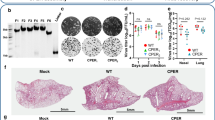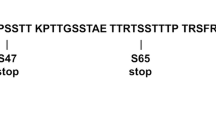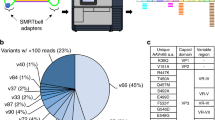Abstract
In this report, we describe the complete 34 794 base pair genomic sequence of the human adenovirus serotype 35 (Ad35) Holden strain. The viral genome exhibits a compact organization similar to other adenoviral serotypes, with overlapping genes on both strands. In all, 47 open reading frames (ORFs) were identified, including early (E1, 2, 3, 4) and late (L1, 2, 3, 4, 5) regions conserved among the adenoviridae family. In addition, 14 ORFs were identified that do not encode known adenoviral genes. Comparison of the predicted translational products of the conserved genes with those of other adenoviruses revealed that Ad35 has high homology to Ad7, Ad3, Ad21, Ad17, and simian Ads25. Based on the complete Ad35 DNA sequence, E3-, E1-, and E1/E3-deleted Ad35-based vector systems were developed. An HEK293-derived cell line was established for the propagation of the E1-deleted Ad35 vector, avoiding the emergence of replication-competent adenovirus. Moreover, production of the E1-deleted recombinant Ad35 vector was achieved by transient transduction of a plasmid encoding the Ad35 E1B gene in HEK293 cells. Testing showed that the Ad35-based vector efficiently infects both human and rhesus macaque dendritic cells. Our novel Ad35-based vectors and their corresponding packaging cell lines will provide a versatile and powerful system for DNA-based vaccine development and gene therapy applications.
This is a preview of subscription content, access via your institution
Access options
Subscribe to this journal
Receive 12 print issues and online access
$259.00 per year
only $21.58 per issue
Buy this article
- Purchase on Springer Link
- Instant access to full article PDF
Prices may be subject to local taxes which are calculated during checkout






Similar content being viewed by others
References
De Jong JC et al. Adenoviruses from human immunodeficiency virus-infected individuals, including two strains that represent new candidate serotypes Ad50 and Ad51 of species B1 and D, respectively. J Clin Microbiol 1999; 37: 3940–3945.
Green M, Mackey JK, Wold WS, Rigden P . Thirty-one human adenovirus serotypes (Ad1–Ad31) form five groups (A–E) based upon DNA genome homologies. Virology 1979; 93: 481–492.
Bewley MC et al. Structural analysis of the mechanism of adenovirus binding to its human cellular receptor, CAR. Science 1999; 286: 1579–1583.
Gall J, Kass-Eisler A, Leinwand L, Falck-Pedersen E . Adenovirus type 5 and 7 capsid chimera: fiber replacement alters receptor tropism without affecting primary immune neutralization epitopes. J Virol 1996; 70: 2116–2123.
Miyazawa N, Crystal RG, Leopold PL . Adenovirus serotype 7 retention in a late endosomal compartment prior to cytosol escape is modulated by fiber protein. J Virol 2001; 75: 1387–1400.
Roberts RJ, O'Neill KE, Yen CT . DNA sequences from the adenovirus 2 genome. J Biol Chem 1984; 259: 13968–13975.
Chroboczek J, Bieber F, Jacrot B . The sequence of the genome of adenovirus type 5 and its comparison with the genome of adenovirus type 2. Virology 1992; 186: 280–285.
Sprengel J et al. Nucleotide sequence of human adenovirus type 12 DNA: comparative functional analysis. J Virol 1994; 68: 379–389.
Chillon M et al. Group D adenoviruses infect primary central nervous system cells more efficiently than those from group C.J Virol 1999; 73: 2537–2540.
Davison AJ et al. The DNA sequence of adenovirus type 40. J Mol Biol 1993; 234: 1308–1316.
Stalder H, Hierholzer JC, Oxman MN . New human adenovirus (candidate adenovirus type 35) causing fatal disseminated infection in a renal transplant recipient. J Clin Microbiol 1977; 6: 257–265.
De Jong PJ, Valderrama G, Spigland I, Horwitz MS . Adenovirus isolates from the urine of patients with the acquired immunodeficiency syndrome. Lancet 1983; 1: 1293–1296.
Flomenberg P et al. Increasing incidence of adenovirus disease in bone marrow transplant recipients. J Infect Dis 1994; 169: 775–781.
Flomenberg PR, Chen PM, Munk G, Horwitz MS . Molecular epidemiology of adenovirus type 35 infections in immunocompromised hosts. J Infect Dis 1987; 155: 1127–1134.
Li QG, Hambraeus J, Wadell G . Genetic relationship between thirteen genome types of adenovirus 11, 34, and 35 with different tropisms. Intervirology 1991; 32: 338–350.
Flomenberg PR, Chen M, Horwitz MS . Sequence and genetic organization of adenovirus type 35 early region 3. J Virol 1998; 62: 4431–4437.
Dunsworth-Browne M, Schell RE, Berk AJ . Adenovirus terminal protein protects single stranded DNA from digestion by a cellular exonuclease. Nucleic Acids Res 1980; 8: 543–554.
Wang K, Xu FY, Ahern KG, Pearson GD . Inverted repeats direct repair of adenovirus minichromosome ends. Virology 1991; 183: 44–51.
Wivel NA, Gao G, Wilson JM . Adenovirus Vectors: The Development of Human Gene Therapy. Cold Spring Harbor Laboratory Press: New York, 1999.
Christ M et al. Modulation of the inflammatory properties and hepatotoxicity of recombinant adenovirus vectors by the viral E4 gene products. Hum Gene Ther 2000; 11: 415–427.
Dedieu JF et al. Long-term gene delivery into the livers of immunocompetent mice with E1/E4-defective adenoviruses. J Virol 1997; 71: 4626–4637.
Graham FL, Smiley J, Russell WC, Naim R . Characteristics of a human cell line transformed by DNA from human adenovirus type 5. J Gen Virol 1977; 36: 59–74.
Wang Q et al. Persistent transgene expression in mouse liver following in vivo gene transfer with a delta E1/delta E4 adenovirus vector. Gene Therapy 1997; 4: 393–400.
Crawford-Miksza L, Schnurr DP . Analysis of 15 adenovirus hexon proteins reveals the location and structure of seven hypervariable regions containing serotype-specific residues. J Virol 1996; 70: 1836–1844.
Gall JG, Crystal RG, Falck-Pedersen E . Construction and characterization of hexon-chimeric adenoviruses: specification of adenovirus serotype. J Virol 1998; 72: 10260–10264.
Pettersson U, Sambrook J . Amount of viral DNA in the genome of cells transformed by adenovirus type 2. J Mol Biol 1973; 73: 125–130.
Hardy S, Kitamura M, Harris-Stansil T, Dai Y, Phipps ML . Construction of adenovirus vectors through Cre-lox recombination. J Virol 1997; 71: 1842–1849.
Acknowledgements
This work was supported by the National Institute of Health Grants IR21AI052806-01 and U01HL66949 (AG). We thank Mrs Huijie Sun for excellent technical assistance.
Author information
Authors and Affiliations
Rights and permissions
About this article
Cite this article
Gao, W., Robbins, P. & Gambotto, A. Human adenovirus type 35: nucleotide sequence and vector development. Gene Ther 10, 1941–1949 (2003). https://doi.org/10.1038/sj.gt.3302097
Received:
Accepted:
Published:
Issue Date:
DOI: https://doi.org/10.1038/sj.gt.3302097
Keywords
This article is cited by
-
Getting genetic access to natural adenovirus genomes to explore vector diversity
Virus Genes (2017)
-
Desmoglein 2 is a receptor for adenovirus serotypes 3, 7, 11 and 14
Nature Medicine (2011)
-
Characterization of human adenovirus 35 and derivation of complex vectors
Virology Journal (2010)
-
Partial protection against SIV challenge by vaccination of adenovirus and MVA vectors in rhesus monkeys
Gene Therapy (2010)
-
Adenovirus serotype 35 vector-mediated transduction following direct administration into organs of nonhuman primates
Gene Therapy (2009)



